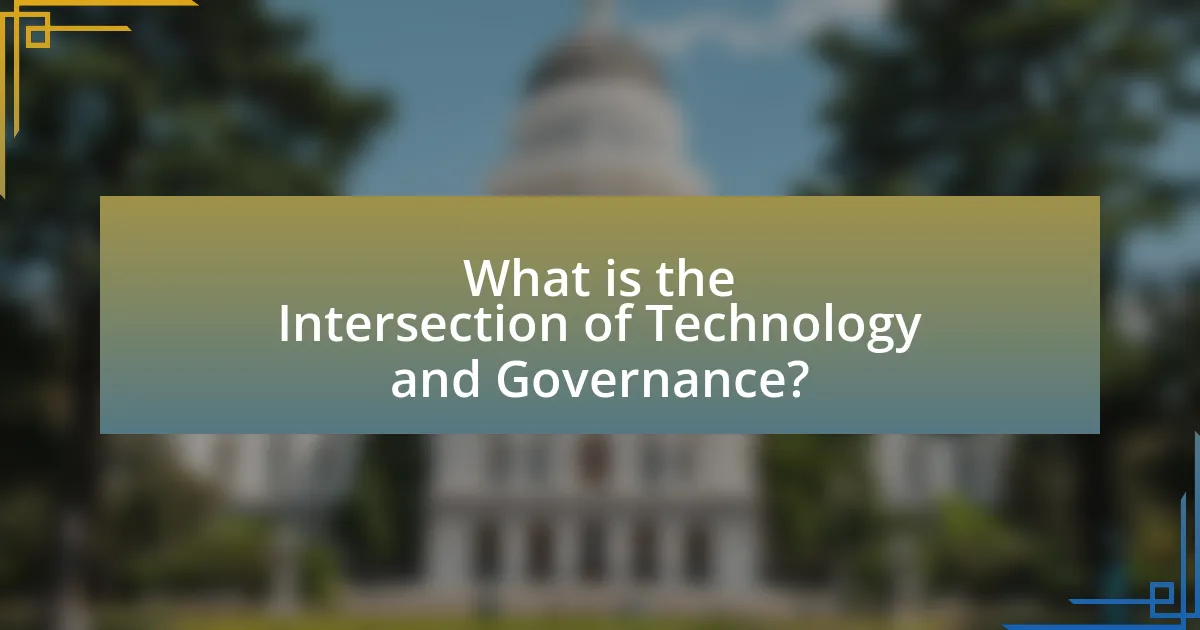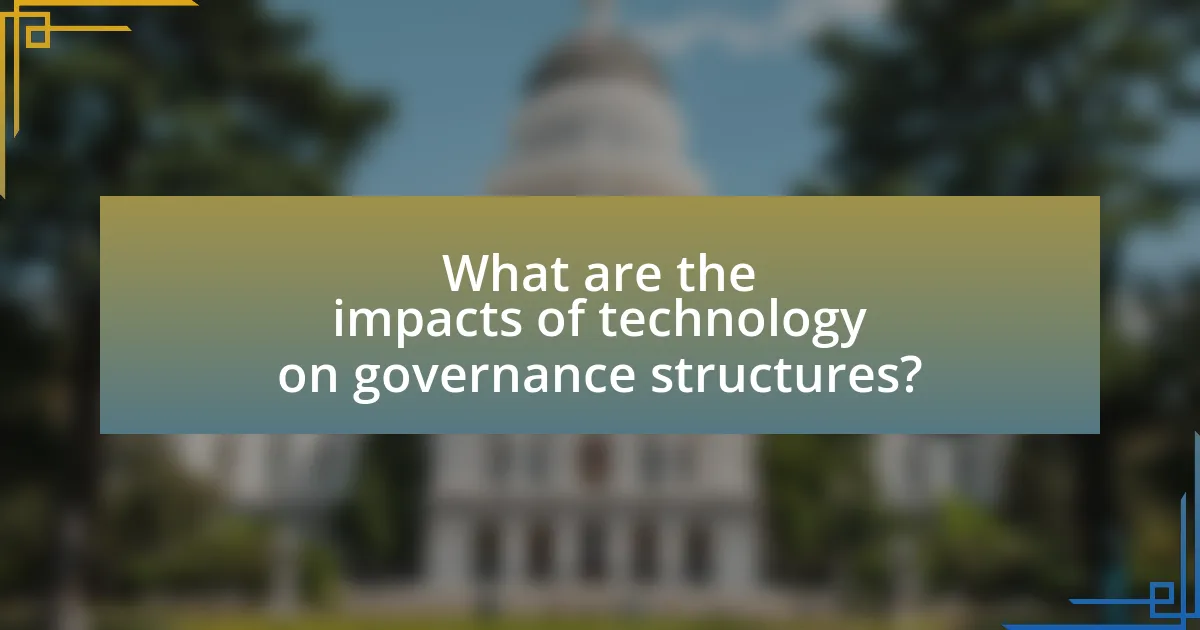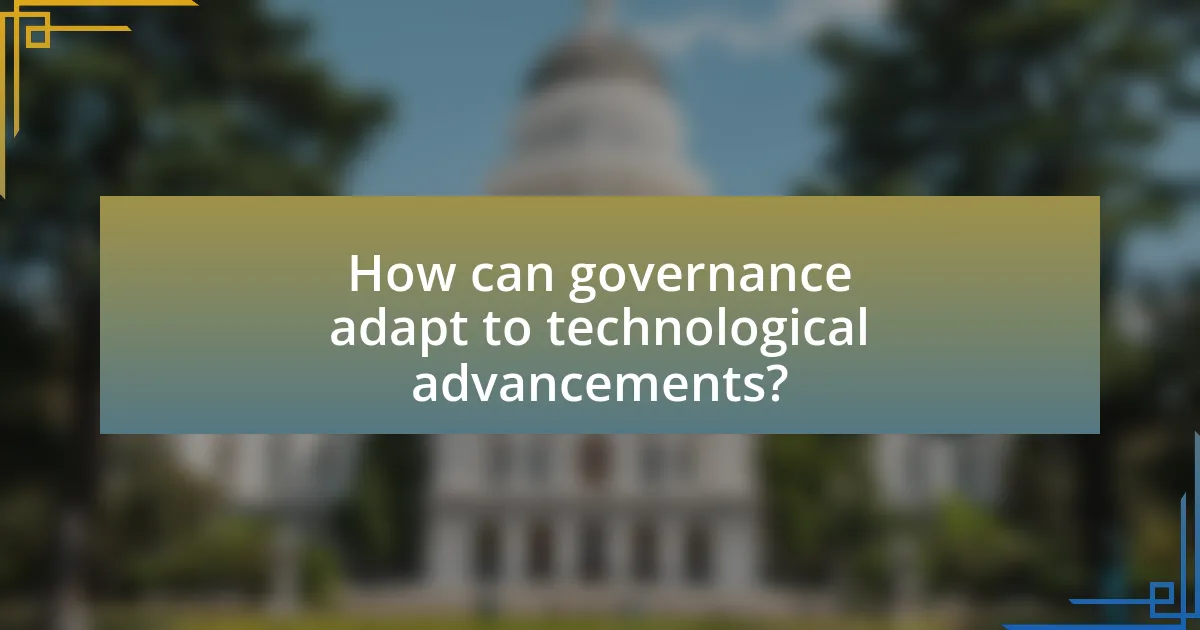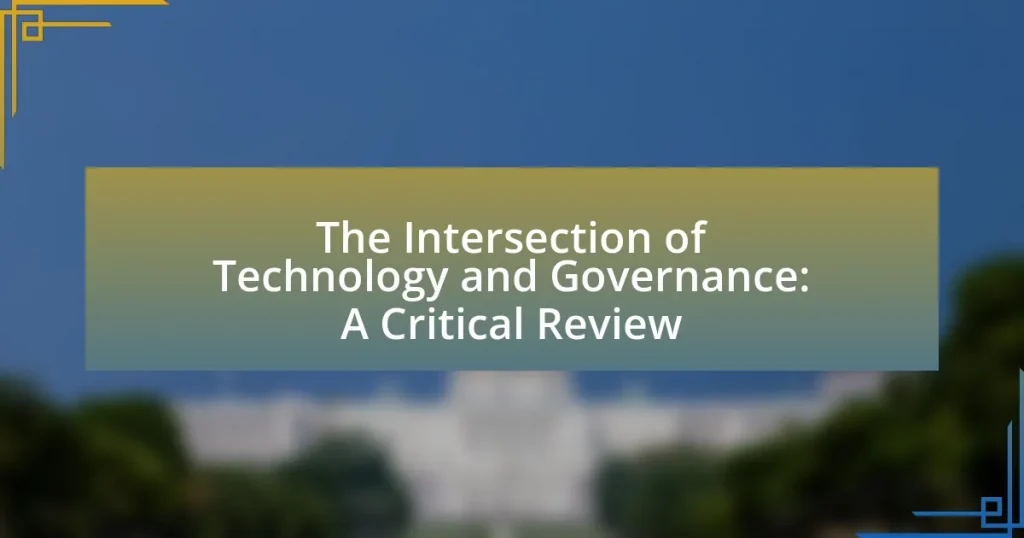The article examines the intersection of technology and governance, highlighting how digital tools enhance public administration and policy-making. It discusses the integration of technologies such as artificial intelligence, blockchain, and big data analytics, which improve efficiency, transparency, and citizen engagement in governance. The article also addresses the challenges and ethical dilemmas posed by technological advancements, including data privacy and cybersecurity concerns. Furthermore, it emphasizes the importance of adaptive regulatory frameworks and stakeholder collaboration to ensure that technology serves the public good while mitigating risks.

What is the Intersection of Technology and Governance?
The intersection of technology and governance refers to the integration of digital tools and systems into the processes of public administration and policy-making. This relationship enhances transparency, efficiency, and citizen engagement in governance. For instance, the use of data analytics in decision-making allows governments to better allocate resources and respond to public needs. Additionally, technologies such as blockchain can improve the integrity of public records and reduce corruption. Evidence of this integration can be seen in initiatives like e-governance platforms, which have been adopted by numerous countries to streamline services and improve accessibility for citizens.
How do technology and governance interact in modern society?
Technology and governance interact in modern society through the integration of digital tools and platforms that enhance decision-making, transparency, and citizen engagement. For instance, e-governance initiatives utilize information and communication technologies to streamline public services, improve access to government information, and facilitate participation in democratic processes. According to a report by the United Nations, as of 2020, 87% of countries had implemented some form of e-governance, demonstrating its widespread adoption and impact on governance structures. This interaction not only increases efficiency but also fosters accountability, as technology enables real-time monitoring of government actions and policies.
What are the key technologies influencing governance today?
Key technologies influencing governance today include artificial intelligence, blockchain, big data analytics, and the Internet of Things (IoT). Artificial intelligence enhances decision-making processes by providing data-driven insights, as seen in predictive analytics used for public policy. Blockchain technology promotes transparency and accountability in government transactions, evidenced by its application in secure voting systems. Big data analytics enables governments to analyze vast amounts of information for better resource allocation and service delivery, demonstrated by cities using data to improve urban planning. The Internet of Things facilitates real-time monitoring of public services, such as smart traffic management systems that optimize city infrastructure. These technologies collectively reshape governance by improving efficiency, transparency, and citizen engagement.
How does governance shape the development of technology?
Governance shapes the development of technology by establishing regulatory frameworks, funding priorities, and ethical guidelines that influence innovation trajectories. For instance, government policies can incentivize research and development in specific sectors, such as renewable energy, by providing grants and tax breaks, which directly impacts technological advancements in those areas. Additionally, regulations regarding data privacy and cybersecurity, such as the General Data Protection Regulation (GDPR) in the European Union, compel technology companies to design their products with compliance in mind, thereby shaping the features and functionalities of emerging technologies. These governance mechanisms ensure that technology evolves in a manner that aligns with societal values and public interests, ultimately guiding the direction and pace of technological progress.
Why is the intersection of technology and governance important?
The intersection of technology and governance is important because it enhances efficiency, transparency, and accountability in public administration. Technology facilitates the collection and analysis of data, enabling governments to make informed decisions and improve service delivery. For instance, the implementation of e-governance initiatives has been shown to reduce bureaucratic delays and increase citizen engagement, as evidenced by the World Bank’s report on digital governance, which highlights that countries adopting digital tools have seen significant improvements in public service efficiency. This synergy between technology and governance ultimately leads to more responsive and effective governance structures.
What are the implications for public policy?
The implications for public policy at the intersection of technology and governance include the need for adaptive regulatory frameworks that address rapid technological advancements. Policymakers must consider issues such as data privacy, cybersecurity, and the ethical use of artificial intelligence, as these factors significantly impact societal trust and safety. For instance, the General Data Protection Regulation (GDPR) in Europe exemplifies a proactive approach to data privacy, demonstrating how legislation can shape technology use while protecting citizens’ rights. Additionally, the rise of digital platforms necessitates policies that promote competition and prevent monopolistic practices, ensuring a fair marketplace. These implications highlight the critical role of informed and responsive governance in harnessing technology for public good while mitigating potential risks.
How does this intersection affect citizen engagement?
The intersection of technology and governance significantly enhances citizen engagement by facilitating more accessible communication and participation in decision-making processes. Digital platforms enable citizens to voice their opinions, access information, and engage with government initiatives in real-time, leading to increased transparency and accountability. For instance, studies show that e-governance initiatives, such as online public consultations, have led to higher participation rates, with some municipalities reporting up to a 50% increase in citizen involvement compared to traditional methods. This shift not only empowers citizens but also fosters a more collaborative relationship between the government and the public, ultimately strengthening democratic processes.
What challenges arise at the intersection of technology and governance?
Challenges at the intersection of technology and governance include issues of data privacy, cybersecurity, and the digital divide. Data privacy concerns arise as governments increasingly rely on technology for surveillance and data collection, leading to potential violations of individual rights. Cybersecurity threats pose risks to critical infrastructure and sensitive information, necessitating robust governance frameworks to protect against attacks. Additionally, the digital divide creates inequalities in access to technology, hindering effective governance and participation in the digital economy. These challenges require comprehensive policies and collaborative efforts between technology developers and government entities to ensure equitable and secure governance in a rapidly evolving technological landscape.
What ethical dilemmas are presented by technological advancements?
Technological advancements present several ethical dilemmas, including privacy concerns, job displacement, and the potential for misuse of technology. Privacy concerns arise as technologies like surveillance systems and data collection tools can infringe on individual rights, leading to debates about consent and data ownership. Job displacement occurs as automation and artificial intelligence replace human labor, raising questions about economic inequality and the future of work. The potential for misuse of technology, such as in the development of autonomous weapons or deepfake technology, poses risks to security and trust in information. These dilemmas highlight the need for ethical frameworks to guide the development and implementation of new technologies.
How do issues of privacy and security manifest in governance?
Issues of privacy and security manifest in governance through the implementation of policies and regulations that aim to protect citizens’ personal data while ensuring national security. Governments often face the challenge of balancing individual privacy rights with the need for surveillance and data collection to prevent crime and terrorism. For instance, the General Data Protection Regulation (GDPR) in the European Union establishes strict guidelines on data handling, emphasizing the importance of privacy in governance. Additionally, incidents like the Cambridge Analytica scandal highlight how misuse of personal data can undermine democratic processes, prompting governments to reassess their security measures and privacy laws.
How can we bridge the gap between technology and governance?
To bridge the gap between technology and governance, it is essential to implement collaborative frameworks that integrate technological advancements into policy-making processes. This can be achieved through the establishment of public-private partnerships, where governments work alongside tech companies to develop regulations that foster innovation while ensuring public safety and ethical standards. For instance, the European Union’s General Data Protection Regulation (GDPR) exemplifies how regulatory frameworks can adapt to technological changes, ensuring data privacy while promoting digital innovation. Additionally, investing in digital literacy programs for policymakers can enhance their understanding of technology, enabling informed decision-making that aligns with contemporary technological realities.
What role do stakeholders play in this intersection?
Stakeholders play a crucial role in the intersection of technology and governance by influencing policy decisions, shaping technological development, and ensuring accountability. Their involvement is essential for aligning technological advancements with public interests and regulatory frameworks. For instance, stakeholders such as government agencies, private companies, civil society organizations, and the public contribute diverse perspectives that can lead to more effective governance strategies. Research indicates that stakeholder engagement enhances transparency and fosters trust, which is vital for the successful implementation of technology in governance.

What are the impacts of technology on governance structures?
Technology significantly impacts governance structures by enhancing transparency, improving efficiency, and facilitating citizen engagement. Digital tools, such as e-governance platforms, allow for real-time access to government data, which fosters accountability and reduces corruption. For instance, the implementation of blockchain technology in public records has been shown to increase trust in governmental processes by ensuring data integrity. Additionally, technology streamlines administrative processes, reducing bureaucratic delays; a study by the McKinsey Global Institute found that digitizing government services can lead to a 20-30% increase in efficiency. Furthermore, social media and mobile applications empower citizens to participate in governance, enabling direct communication with officials and influencing policy decisions. These advancements illustrate how technology reshapes governance by making it more responsive and participatory.
How does technology enhance transparency in governance?
Technology enhances transparency in governance by enabling real-time access to information and facilitating open communication between government entities and citizens. Digital platforms, such as e-governance portals and mobile applications, allow citizens to track government activities, budgets, and decision-making processes. For instance, the implementation of open data initiatives in various countries has led to increased public access to government data, which fosters accountability and encourages civic engagement. According to a study by the World Bank, countries that adopted e-governance practices saw a significant improvement in public trust and participation, demonstrating that technology effectively promotes transparency in governance.
What tools are used to promote transparency?
Tools used to promote transparency include open data platforms, blockchain technology, and transparency reporting software. Open data platforms, such as data.gov, provide public access to government data, enabling citizens to scrutinize and engage with governmental processes. Blockchain technology enhances transparency by creating immutable records of transactions, which can be audited by any party, thereby reducing fraud and increasing trust. Transparency reporting software, like Google’s Transparency Report, allows organizations to disclose information about data requests and content removals, fostering accountability. These tools collectively enhance public oversight and trust in governance.
How does transparency affect public trust in governance?
Transparency significantly enhances public trust in governance by fostering accountability and reducing corruption. When governments operate transparently, citizens can access information about decision-making processes, expenditures, and policies, which builds confidence in the integrity of their leaders. Research conducted by the World Bank indicates that increased transparency can lead to a 20% reduction in corruption levels, thereby improving public perception of government effectiveness. Furthermore, studies show that when citizens perceive their government as open and honest, their trust levels increase, leading to higher civic engagement and compliance with laws.
In what ways does technology improve efficiency in governance?
Technology improves efficiency in governance by streamlining processes, enhancing communication, and enabling data-driven decision-making. Digital platforms facilitate faster service delivery, reducing bureaucratic delays; for instance, e-governance initiatives have shown that online services can cut processing times by up to 50%. Additionally, technology fosters transparency and accountability through real-time data sharing, which can lead to improved public trust. A study by the World Bank indicated that countries implementing digital governance tools experienced a 20% increase in citizen satisfaction due to more accessible information and services. Furthermore, data analytics allows governments to allocate resources more effectively, optimizing public spending and improving service outcomes.
What specific technologies are most effective in streamlining processes?
Robotic Process Automation (RPA), Artificial Intelligence (AI), and cloud computing are the most effective technologies in streamlining processes. RPA automates repetitive tasks, reducing human error and increasing efficiency; for instance, companies using RPA have reported up to a 30% reduction in processing time. AI enhances decision-making through data analysis and predictive analytics, enabling organizations to optimize workflows; a study by McKinsey found that AI can improve productivity by up to 40%. Cloud computing facilitates real-time collaboration and access to resources, which accelerates project timelines and reduces operational costs; according to Gartner, organizations that adopt cloud solutions can save up to 20% on IT expenses.
How do these efficiencies impact service delivery to citizens?
Efficiencies in technology and governance significantly enhance service delivery to citizens by streamlining processes and reducing response times. For instance, the implementation of digital platforms allows for quicker access to services, such as online applications for permits or licenses, which can reduce processing times from weeks to days. According to a study by the McKinsey Global Institute, digitizing government services can lead to a 20-30% reduction in operational costs, enabling governments to allocate resources more effectively and improve service quality. This increased efficiency not only improves citizen satisfaction but also fosters greater trust in governmental institutions.
What are the risks associated with technology in governance?
The risks associated with technology in governance include data privacy breaches, cybersecurity threats, and the potential for algorithmic bias. Data privacy breaches can occur when sensitive information is inadequately protected, leading to unauthorized access and misuse, as evidenced by incidents like the Equifax data breach in 2017, which exposed the personal information of approximately 147 million people. Cybersecurity threats pose significant risks, as government systems are increasingly targeted by cyberattacks, exemplified by the 2020 SolarWinds hack, which compromised numerous U.S. federal agencies. Additionally, algorithmic bias can result in unfair treatment of individuals based on flawed data or biased algorithms, as highlighted in studies showing racial bias in facial recognition technology. These risks necessitate careful consideration and management to ensure the integrity and fairness of governance systems.
How can technology lead to increased surveillance and control?
Technology can lead to increased surveillance and control through the deployment of advanced monitoring systems, data analytics, and artificial intelligence. These technologies enable governments and organizations to collect vast amounts of data on individuals, including their movements, communications, and online activities. For instance, facial recognition technology has been adopted in various public spaces, allowing for real-time identification and tracking of individuals, which enhances state surveillance capabilities. Additionally, the use of big data analytics allows for the processing of this information to identify patterns and predict behaviors, further tightening control over populations. Reports indicate that countries like China have implemented extensive surveillance networks, integrating technologies such as AI and the Internet of Things to monitor citizens continuously, demonstrating the potential for technology to facilitate pervasive oversight and regulation.
What are the potential consequences of technology failures in governance?
Technology failures in governance can lead to significant consequences, including loss of public trust, inefficiencies in service delivery, and potential security breaches. When technology systems fail, citizens may lose confidence in their government’s ability to manage resources effectively, as evidenced by incidents like the 2013 Healthcare.gov launch, which faced severe technical issues, undermining public trust in the Affordable Care Act. Additionally, failures can disrupt essential services, leading to delays in critical operations, as seen during the 2020 COVID-19 pandemic when many governments struggled with inadequate digital infrastructure for contact tracing and information dissemination. Furthermore, technology failures can expose sensitive data to cyber threats, as demonstrated by the 2020 ransomware attack on the City of New Orleans, which compromised city operations and highlighted vulnerabilities in governance systems.

How can governance adapt to technological advancements?
Governance can adapt to technological advancements by implementing flexible regulatory frameworks that encourage innovation while ensuring public safety and ethical standards. For instance, countries like Estonia have successfully integrated digital governance by utilizing e-residency and blockchain technology, which streamlines administrative processes and enhances transparency. This adaptation is supported by the increasing reliance on data-driven decision-making, as evidenced by the World Economic Forum’s report highlighting how data analytics can improve policy outcomes. By embracing technology, governance can enhance citizen engagement, improve service delivery, and respond more effectively to emerging challenges.
What strategies can be employed to integrate technology into governance?
Strategies to integrate technology into governance include adopting e-governance platforms, utilizing data analytics for decision-making, and implementing blockchain for transparency. E-governance platforms streamline public services, enhancing citizen engagement and accessibility; for instance, countries like Estonia have successfully digitized their government services, resulting in increased efficiency and citizen satisfaction. Data analytics enables governments to analyze large datasets to inform policy decisions, as seen in the use of predictive analytics in urban planning in cities like Barcelona. Blockchain technology enhances transparency and accountability in governance by providing immutable records of transactions, which has been effectively demonstrated in supply chain management by governments in countries like Dubai.
How can policymakers stay informed about emerging technologies?
Policymakers can stay informed about emerging technologies by engaging with expert networks, attending industry conferences, and utilizing research from academic institutions. Expert networks provide insights and updates on technological advancements, while industry conferences offer opportunities for direct interaction with innovators and thought leaders. Research from academic institutions, such as studies published in journals like “Technology and Society,” provides evidence-based analysis of technological trends and their implications for governance. These methods ensure that policymakers remain knowledgeable about the rapid developments in technology, enabling informed decision-making.
What role does education play in adapting governance to technology?
Education plays a crucial role in adapting governance to technology by equipping policymakers and public servants with the necessary skills and knowledge to understand and implement technological advancements effectively. This understanding enables them to create informed regulations and policies that address the complexities of technology, such as data privacy, cybersecurity, and digital equity. For instance, research from the OECD highlights that countries investing in digital skills training for government officials see improved governance outcomes, as these officials can better navigate the challenges posed by rapid technological changes.
What best practices can be adopted for effective governance in a tech-driven world?
Effective governance in a tech-driven world can be achieved by adopting best practices such as transparency, accountability, and stakeholder engagement. Transparency ensures that decision-making processes are open and accessible, allowing citizens to understand how technology is being utilized in governance. For instance, the implementation of open data initiatives has been shown to enhance public trust and participation, as evidenced by the success of cities like New York, which has made extensive datasets available to the public.
Accountability is crucial, as it holds government officials and organizations responsible for their actions, particularly in the use of technology. The establishment of independent oversight bodies can help monitor the ethical use of technology, as seen in countries like Estonia, where digital governance is closely regulated to prevent misuse.
Stakeholder engagement involves actively involving citizens, businesses, and civil society in the governance process, ensuring that diverse perspectives are considered. This practice has been effectively implemented in participatory budgeting initiatives in cities like Porto Alegre, Brazil, where citizens directly influence budget allocations through technology platforms.
By integrating these best practices, governance can become more effective and responsive in a technology-driven environment.
How can collaboration between tech companies and governments be fostered?
Collaboration between tech companies and governments can be fostered through the establishment of public-private partnerships that focus on shared goals, such as innovation and public welfare. These partnerships can facilitate knowledge sharing, resource allocation, and joint initiatives that address societal challenges, such as cybersecurity and digital infrastructure. For instance, the U.S. government has engaged in partnerships with tech firms like Microsoft and Google to enhance cybersecurity measures, demonstrating a successful model of collaboration that benefits both sectors. Additionally, creating regulatory frameworks that encourage innovation while ensuring accountability can further strengthen these collaborations, as seen in the European Union’s Digital Services Act, which aims to regulate online platforms while promoting technological advancement.
What frameworks exist for ethical technology use in governance?
Several frameworks exist for ethical technology use in governance, including the OECD Principles on Artificial Intelligence, the EU’s Ethics Guidelines for Trustworthy AI, and the IEEE Global Initiative on Ethics of Autonomous and Intelligent Systems. The OECD Principles emphasize transparency, accountability, and fairness in AI systems, while the EU guidelines focus on ensuring that AI is lawful, ethical, and robust. The IEEE initiative provides a comprehensive approach to ethical considerations in the design and implementation of intelligent systems. These frameworks are supported by various studies and reports that highlight the importance of ethical standards in technology governance to promote public trust and mitigate risks associated with emerging technologies.
What are the future trends at the intersection of technology and governance?
Future trends at the intersection of technology and governance include the increasing use of artificial intelligence for decision-making, enhanced data transparency through blockchain, and the rise of digital identity systems. Artificial intelligence is being integrated into public policy to analyze data and predict outcomes, which can lead to more informed governance. Blockchain technology is promoting transparency and accountability in government operations, as seen in initiatives like Estonia’s e-Residency program, which allows secure digital identities for citizens. Additionally, digital identity systems are being developed to streamline access to services and improve citizen engagement, as evidenced by India’s Aadhaar system, which has registered over a billion citizens. These trends indicate a shift towards more efficient, transparent, and citizen-centric governance models.
How might artificial intelligence reshape governance practices?
Artificial intelligence may reshape governance practices by enhancing decision-making processes through data-driven insights and predictive analytics. AI can analyze vast amounts of data to identify trends and inform policy decisions, leading to more effective governance. For instance, AI algorithms can optimize resource allocation in public services, as demonstrated by cities using AI to improve traffic management and reduce congestion, resulting in better urban planning. Additionally, AI can facilitate citizen engagement by providing platforms for real-time feedback and participation, thereby increasing transparency and accountability in governance.
What emerging technologies should governance be prepared for?
Governance should be prepared for emerging technologies such as artificial intelligence, blockchain, quantum computing, and the Internet of Things (IoT). These technologies are reshaping various sectors, necessitating adaptive regulatory frameworks. For instance, artificial intelligence is projected to contribute up to $15.7 trillion to the global economy by 2030, highlighting its transformative potential. Blockchain technology enhances transparency and security in transactions, which is crucial for governance in sectors like finance and supply chain management. Quantum computing, with its ability to solve complex problems exponentially faster than classical computers, poses both opportunities and challenges for data security and encryption. Lastly, the IoT connects billions of devices, creating vast amounts of data that require effective governance to address privacy and security concerns.
What practical steps can governments take to leverage technology effectively?
Governments can leverage technology effectively by implementing comprehensive digital infrastructure, enhancing cybersecurity measures, and promoting digital literacy among citizens. Establishing robust digital infrastructure allows for efficient service delivery and data management, as evidenced by Estonia’s e-government system, which streamlines public services and increases citizen engagement. Enhancing cybersecurity is crucial, as demonstrated by the increasing number of cyberattacks on government systems; for instance, the 2020 SolarWinds attack highlighted vulnerabilities that can be mitigated through improved security protocols. Finally, promoting digital literacy ensures that citizens can effectively utilize technology, as seen in Singapore’s Smart Nation initiative, which focuses on equipping the population with necessary digital skills to participate in a technology-driven society.















